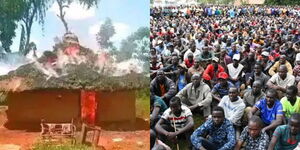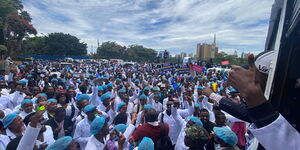A number of families on Saturday, March 27, woke up to their houses being demolished in Nairobi's Njiru area.
The incident is reported to have caught many of the residents by surprise as they claimed not to have been issued eviction notices.
The residents scrambled to salvage their property as the bulldozers descended on their houses flattening them to the ground.
In response, the residents held protests, resulting in a huge traffic snarl-up along Kangundo road. Motorists were advised to use alternative routes as police moved to contain the situation.
There were also reports of injuries that occurred during the demolitions. but which Kenyans.co.ke could not independently confirm.
The demolitions were conducted in a similar manner to the Ruai and Kariobangi demolitions in 2020.
The exercise was conducted after the government began the process of evicting people who settled on the disputed 3,000-acre piece of land, to pave way for the expansion of the Dandora Sewerage Treatment Plant in Ruai, Nairobi.
The Dandora Sewerage Treatment Plant, which stands next to the property repossessed back in April, was built in 1980 and was initially meant to serve city residents.
On May 3, 2020, over 8,000 residents of Kariobangi Sewage Estate in Nairobi were left homeless after the government moved to demolish their settlements.
The exercise was overseen by the Ministries of Land and Water in a move to reclaim the land parcel that had been reserved for sewerage facilities.
At the time, Principal Secretary Ministry of Water and Sanitation Joseph Irungu, argued that the construction of the Kariobangi and Dandora-Ruai sewage treatment plants was vital for the country's capital city.
"We’ll reclaim any land belonging to Nairobi Water and Sewerage Company.
"It's not very easy and it has a lot of emotions but we have to set aside the emotions and face reality. In this case, we won't take our sewage treatment plants to neighbouring counties, we have to manage it within the designated areas within Nairobi County," he explained.












